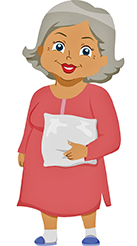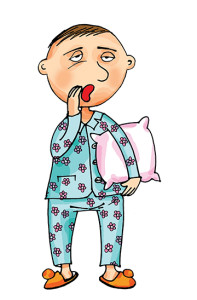Picking the Perfect Pillow
Posted on July 1, 2016 by bob in Features, Health

by Claire Yezbak Fadden
I’d spent the better part of the night fluffing, bending and punching my pillow. No matter which way I turned it, it wouldn’t contour to my head. The next morning, I woke up with a stiff neck. Convinced I was sleeping on the wrong pillow, I set out to find a better one. After a bit of research, I learned all pillows aren’t created equal. Even the way you sleep can lead to restless nights. If you’ve lost sleep because you nestled your head on an unsuitable cushion, consider these tips before you start your quest for the perfect pillow.
Sleeping Styles
Pillows are constructed differently to accommodate different sleep positions, according to Rachael Risinger, a spokesman for Bed, Bath & Beyond. “One of the most important factors to consider when purchasing a pillow is the position in which you sleep,” she said. Researchers at the Johns Hopkins Sleep Disorders Center agree, suggesting that it’s important to know your sleeping style.
If you sleep on your stomach, a softer pillow works since it allows your neck and spine to release into a flatter angle. Back sleepers are more comfortable using a medium to firm pillow to provide needed support. If you sleep on your side, the best choice for you is a firmer pillow.
Pillow Filling & Density
What’s inside the pillow is important too. “Knowing the difference among some common pillow fills can assist in making a better choice,” Risinger said.
Natural fill pillows are made of feathers or down or a combination to create its core. They are long lasting so you avoid having to replace your pillow more frequently. A synthetic-filled pillow is an economical alternative to down. They are composed of man-made materials, and since they are easily laundered, they are often the choice of allergy-sufferers. You will need to replace them more frequently, cautions Risinger.
Many people choose memory-foam pillows because they easily contour to the shape of your head and neck. They are especially comfortable to sleepers who prefer a firm pillow. “These pillows feel dense,” said Risinger, “but they soften to conform to your head. They can help adjust sleep positions to alleviate aches, pains and snoring.”
Water-based pillows offer the flexibility of increasing or decreasing the pillow height simply by releasing or adding water. These pillows “showed a significant advantage over the roll pillow and the standard pillow” in relation to neck or cervical pain, according to a study by the Johns Hopkins Sleep Disorders Center.
Pillow Types
“Typical bed pillows range from 4-6 inches in height,” said Risinger. “This measurement refers to the crown, which is the center of the pillow.” Before you buy it, try it out. If it feels too high and fluffy, it can cause neck pain from sleeping at an awkward angle. If it feels too low and flat, it may not support your neck correctly.
What’s it Going to Cost?
Less-expensive pillows from the discount store might seem like a great value in the short term, but they tend to flatten quickly and need to be replaced more often. An old pillow can cause improper neck alignment according to sleep expert Michael Breus, Ph.D.
“It can throw off a person’s entire spine, resulting in back, neck and leg pain, headaches and sleep deprivation,” he said. Natural pillows cost more than most synthetics, but they also more durable. Water-based and memory-foam pillows can be expensive, but if they provide you with your best night’s sleep or alleviate neck and back pain, they are worth the extra cost.
Brues, who authored “The Sleep Doctor’s Diet Plan: Lose Weight Through Better Sleep” recommends changing your good quality pillows at least every one to two years. “Change less expensive ones more often than that,” he added. If you have allergies or asthma, the National Sleep Foundation suggests purchasing a hypoallergenic cover designed to protect from possible allergic triggers such as dust mites.
Freelance writer Claire Yezbak Fadden, a side sleeper, is happy with her new firm-support pillow. Follow her on Twitter @claireflaire.
Kids and Pillows
Although parents and grandparents like the idea of decorative pillows, the American Academy of Pediatrics (AAP) advises against using them as well as blankets and bumpers during the first year of baby’s life. Though they’re often sold with crib bedding sets, pillows are not recommended for children under 2 because kids that small can easily suffocate while using one. To learn more, download a pdf of the AAP’s “A Parents’ Guide to Safe Sleep,” at healthychildcare.org and search “pillows.”









